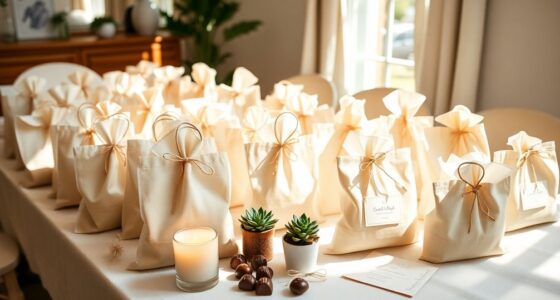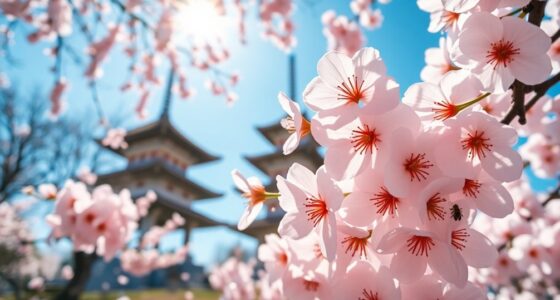Looking for fun and relaxing retreat ideas for adults? You might consider wellness and spa retreats where you can indulge in luxurious treatments and rejuvenating therapies. If you crave adventure, hiking, kayaking, or rock climbing can energize you while you explore stunning landscapes. Creative retreats like painting sessions or team-building scavenger hunts foster social connections and spark creativity. Nature-based activities such as mindfulness meditation or nature walks offer tranquility and deeper relaxation. Whichever path you choose, these retreats promise memorable experiences that blend joy and relaxation. There's so much more to uncover about the perfect retreat for you!
Key Takeaways
- Enjoy luxurious wellness treatments like stem cell therapy or geothermal pools for a rejuvenating experience.
- Engage in creative activities such as painting classes and music sessions to express artistic talents.
- Participate in nature-based retreats that include therapeutic yoga, meditation, and tech-free nature walks.
- Experience adventure through hiking, rock climbing, or water sports to boost fitness and confidence.
- Practice mindfulness with guided meditations and sensory activities like mindful eating to enhance relaxation.
Wellness and Spa Retreats

When you're seeking a getaway that rejuvenates both body and mind, wellness and spa retreats offer the perfect escape.
Picture yourself indulging in luxurious treatments like stem cell and ozone therapies in Maui or soaking in geothermal pools in Calistoga.
You can find tranquility at The Lodge at Woodloch, where forest bathing and float therapy await you in Pennsylvania's serene woodlands. Additionally, many retreats, such as Ananda in the Himalayas, emphasize the integration of Ayurveda and yoga to enhance your wellness journey.
Consider a holistic experience at Ananda in the Himalayas, where expert-led yoga and Ayurveda enhance your wellness journey.
Alternatively, unwind with lymphatic drainage massages and daily fitness sessions at Wellness Collective in Rancho Santa Fe.
No matter where you go, these retreats promise relaxation and a chance to recharge your spirit.
Adventure and Physical Activity

Adventure and physical activity retreats offer an exhilarating escape that invigorates both body and spirit. You can immerse yourself in hiking retreats that let you explore breathtaking landscapes while honing your fitness. If you're keen for a challenge, rock climbing and rappelling sessions build strength and confidence, all while enjoying stunning views. Water sports like kayaking or surfing not only enhance endurance but also provide a thrilling experience. For cycling enthusiasts, mountain biking retreats teach bike maintenance and tackle diverse trails. Finally, adventure sports getaways let you push your limits with obstacle courses and eco-challenges. These retreats often include specialized training to help participants improve their skills and performance in specific activities.
Whatever your choice, these activities foster teamwork, promote wellness, and create unforgettable memories. So gear up for an adventure that energizes you!
Creative and Social Retreats
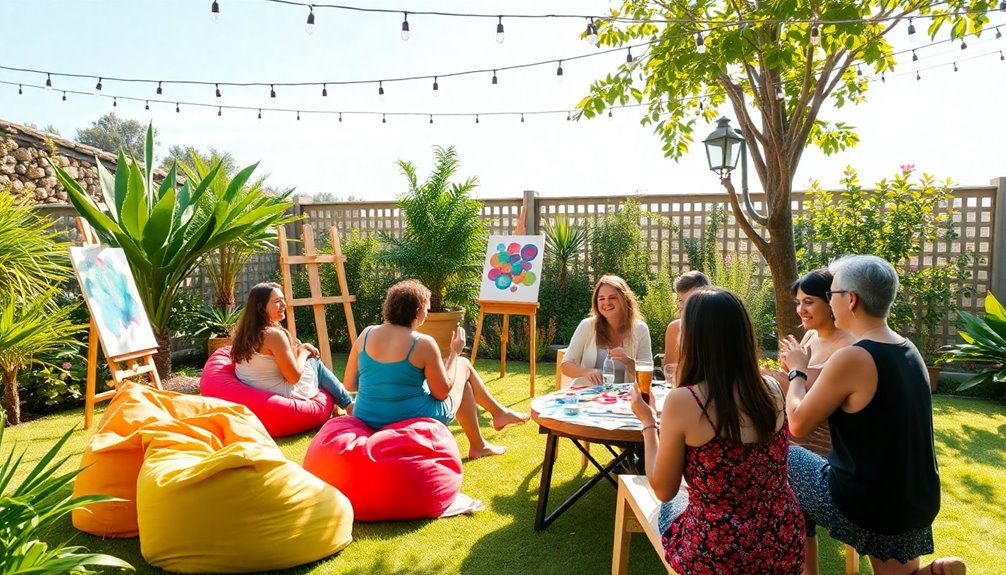
Creative and social retreats provide a unique opportunity to release your imagination while building connections with others.
You can immerse yourself in artistic expression through painting classes, adult coloring books, or journaling. Explore music and performance by learning an instrument or participating in open mic sessions. Incorporating activities like mindfulness retreats can further enhance your creative flow while promoting relaxation.
For social interaction, engage in team-building activities like scavenger hunts and trivia games, or enjoy low-key board games.
These experiences foster collaboration, spark creativity, and create lasting memories.
Whether through artistic endeavors or social games, you'll leave feeling inspired and connected to a vibrant community of like-minded individuals.
Nature-Based Retreats
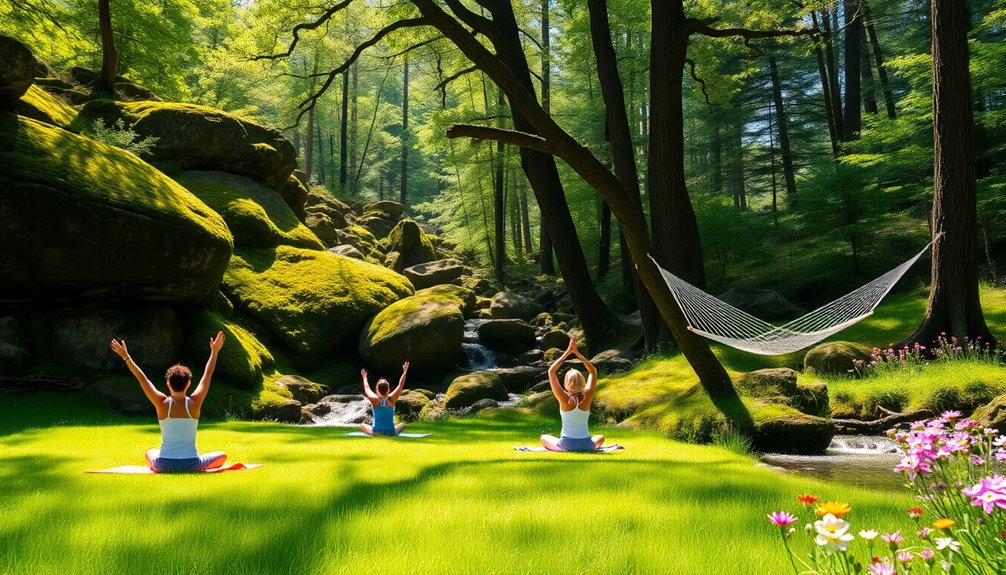
Imagine immersing yourself in a serene environment with nature walks that allow you to recharge without technology. You can enhance your experience by going barefoot or participating in an outdoor scavenger hunt, perhaps enjoying a light breakfast like cinnamon sugar French toast bites to fuel your morning.
Consider beachfront retreats or secluded forest immersions for deep relaxation. Therapeutic activities like yoga, mindfulness meditation, and sound healing can further enrich your time. These activities are designed to enhance mental wellbeing through immersion in natural environments.
Engage in group activities such as team sports or camping, fostering connections with others. Choose venues that prioritize accessibility and safety, ensuring a memorable retreat tailored to your needs.
Nature's embrace awaits—are you ready to explore?
Relaxation and Mindfulness Activities
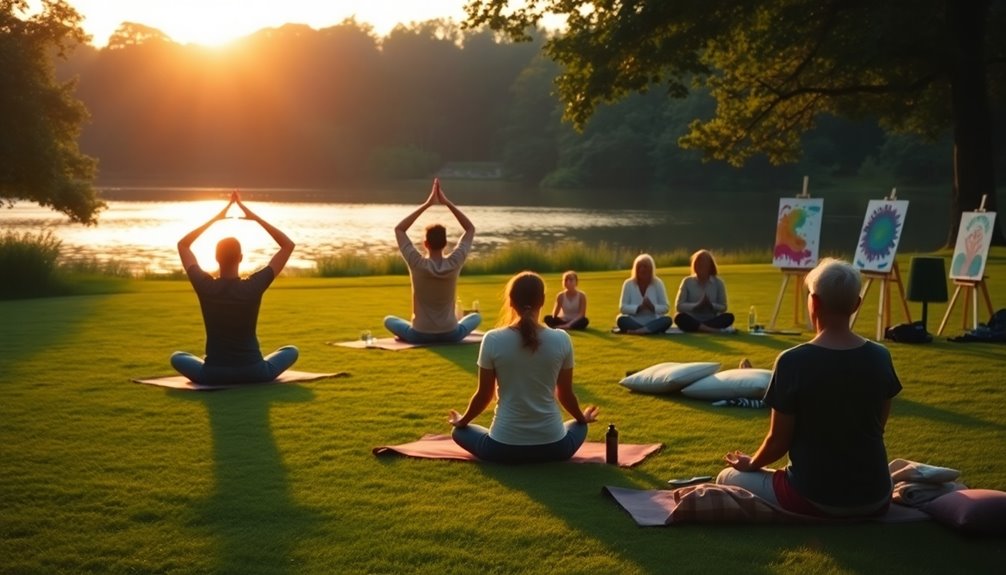
As you seek to cultivate inner peace, relaxation and mindfulness activities offer powerful tools to help you reconnect with yourself and the present moment.
Try mindfulness meditation or breathing exercises like the 4-7-8 breath to calm your nervous system. Engaging in creative activities such as pottery or cooking classes allows you to focus fully on the task at hand, enhancing your awareness. Practicing mindfulness in daily life not only enriches your experiences but also fosters a greater sense of connection to your surroundings.
Sensory-based practices, like mindful eating or the five senses exercise, deepen your appreciation of everyday experiences. Guided techniques, including mountain or lake meditations, help ground you in tranquility.
Incorporate these activities into your retreat, and you'll discover a renewed sense of warmth, joy, and connection to both yourself and the world around you.
Frequently Asked Questions
What Should I Pack for a Retreat?
When you're packing for a retreat, think about comfort and essentials. Bring casual and athletic outfits, along with swimsuits and appropriate footwear.
Don't forget toiletries like your toothbrush, shampoo, and deodorant. Pack a sleeping bag, towels, and a first aid kit for safety.
Include your smartphone charger, a reusable water bottle, and some snacks.
Finally, grab a personal journal, pen, and pajamas to make certain you're ready for any experience that comes your way.
Are Meals Included in Retreat Packages?
When you choose a retreat package, like the one at Bungalows Key Largo, you'll find that all meals are included.
This means you can savor everything from fine dining to casual bites without worrying about extra costs.
Most retreats offer various dining options to cater to your dietary needs, ensuring you enjoy nutritious meals throughout your stay.
Can I Attend Alone or Is It Group-Focused?
You can absolutely attend alone or join a group-focused retreat.
Solo retreats offer a personalized experience, allowing you to tailor your itinerary and focus on self-reflection.
On the other hand, group retreats foster connection and shared experiences, providing opportunities for collaboration and diverse perspectives.
It really depends on what you're looking for—whether you want solitude or camaraderie, both options have unique benefits that cater to your needs and preferences.
What Is the Typical Duration of a Retreat?
Did you know that most retreats last between 3 to 7 days? This duration strikes a balance, letting you disconnect without feeling overwhelmed.
Weekend retreats typically run from Friday evening to Sunday afternoon, while 5-day retreats offer a deeper experience.
If you're looking for immersion, a 7-day retreat is ideal. Ultimately, the perfect length depends on your goals, schedule, and the retreat's focus, ensuring you get the most out of your time away.
Are Retreats Suitable for Beginners in Fitness?
Yes, retreats are definitely suitable for beginners in fitness!
You'll find expert guidance from personal trainers and yoga instructors who'll teach you proper techniques. Plus, a supportive environment filled with like-minded individuals motivates you to push your limits.
With a mix of structured schedules and various activities, you can explore new workouts without feeling overwhelmed.
It's a perfect place for personal growth, building confidence, and setting achievable fitness goals.
Conclusion
Whether you're unwinding at a serene spa, tackling a thrilling hike, or releasing your creativity in a workshop, each retreat offers a unique escape. Imagine yourself surrounded by vibrant nature, feeling the soothing breeze, or savoring a delicious meal with new friends. The choice is yours: will you plunge into adventure or embrace tranquility? Whichever path you take, let the experience rejuvenate your spirit and spark joy in your everyday life. What will your retreat look like?


